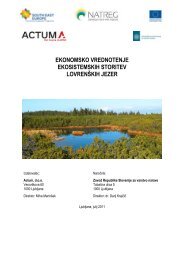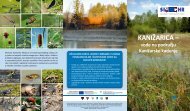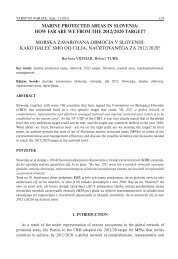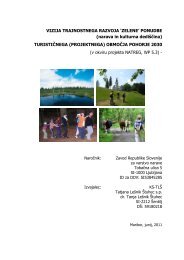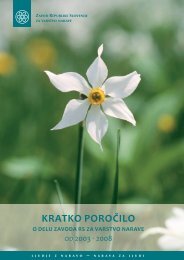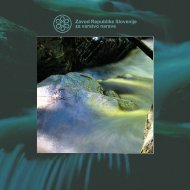Monitoring MPA visitor uses handbook
Monitoring MPA visitor uses handbook
Monitoring MPA visitor uses handbook
- No tags were found...
You also want an ePaper? Increase the reach of your titles
YUMPU automatically turns print PDFs into web optimized ePapers that Google loves.
4. Selecting and adapting yourindicatorsThe suggested indicators allow the various aspects of <strong>visitor</strong> use in <strong>MPA</strong>s to be studied in a standardized manner.The information obtained with these indicators will be all the more relevant if they are correctly selected and adaptedto the manager's project.4.1 Presentation of the indicatorsEighteen indicators for monitoring <strong>visitor</strong> use of Mediterranean<strong>MPA</strong>s are proposed and organised in five categories(chapter 5).be obtained from competent organisations. However,manual or automated counts generally need to be doneacross the entire <strong>MPA</strong> or a portion of it. Tools includehandheld counters or they may be automated like ecocounters.QuantitativeindicatorsQualitative andbehaviouralindicatorsBaseline dataSafety indicatorCross-disciplinaryindicatorsTable 2 : Visitor use monitoring indicators5.1 Water and waste5.2 Passenger transport bysea5.3 Road and path use5.4 Moorage area use5.5 Recreational fishing siteuse5.6 Diving site use5.7.1 User profiles andactivities5.7.2 User perception andsatisfaction5.7.3 Knowledge andperception of regulations5.8 Compliance withregulations5.9 Emerging activities andpractices5.10 Weather conditions5.11 Land-basedaccommodation capacity5.12 Capacity at sea5.13 Rental vehicle fleet5.14 Emergency response5.15.1 Visitor use /environment interaction5.15.2 Economic benefits of<strong>visitor</strong> use4.1.1 Quantitative indicatorsThe six quantitative indicators provide fundamental numericaldata for any <strong>visitor</strong> use monitoring project andstudies into its management. These indicators providean evaluation of the extent of <strong>visitor</strong> use, the distributionof various <strong>uses</strong> in time and space, and the dynamics of<strong>visitor</strong> flows.In some cases, quantitative data already exists and canManual count of boats mooring in Morgiou calanque, Les Calanques NationalPark in France. © Credit: Parc National des Calanques4.1.2 Qualitative and behaviouralindicatorsThe five qualitative and behavioural indicators determinethe characteristics of <strong>MPA</strong> users and their practices.They also deliver knowledge of their expectations,perceptions and degree of satisfaction. This informationis particularly important to subsequently adapt themanagement of these groups or prevent any conflictsbetween <strong>uses</strong>. It is also vital for good interpretation ofthe quantitative results.In most cases, surveys among the various user categorieswill be needed for these indicators. Particular attentionmust be paid when designing surveys to avoid allbias in the questionnaire and the interpretation of results.Assistance from an expert in human and social scienceswill be necessary.4.1.3 Baseline dataBy measuring a number of variables and factors that influence<strong>MPA</strong> use, the four baseline data indicators (weatherconditions, land and sea accommodation capacities,rental fleet) provide vital insight for understandingthe quantitative, qualitative and behavioural indicators.Such baseline data is very often obtained from competentorganisations (tourist boards, meteorologicalagencies, port authorities, etc.). TABLE OF CONTENTS 15 COLLECTION VISITOR USE OBSERVATION AND MONITORING IN MEDITERRANEAN MARINE PROTECTED AREAS



